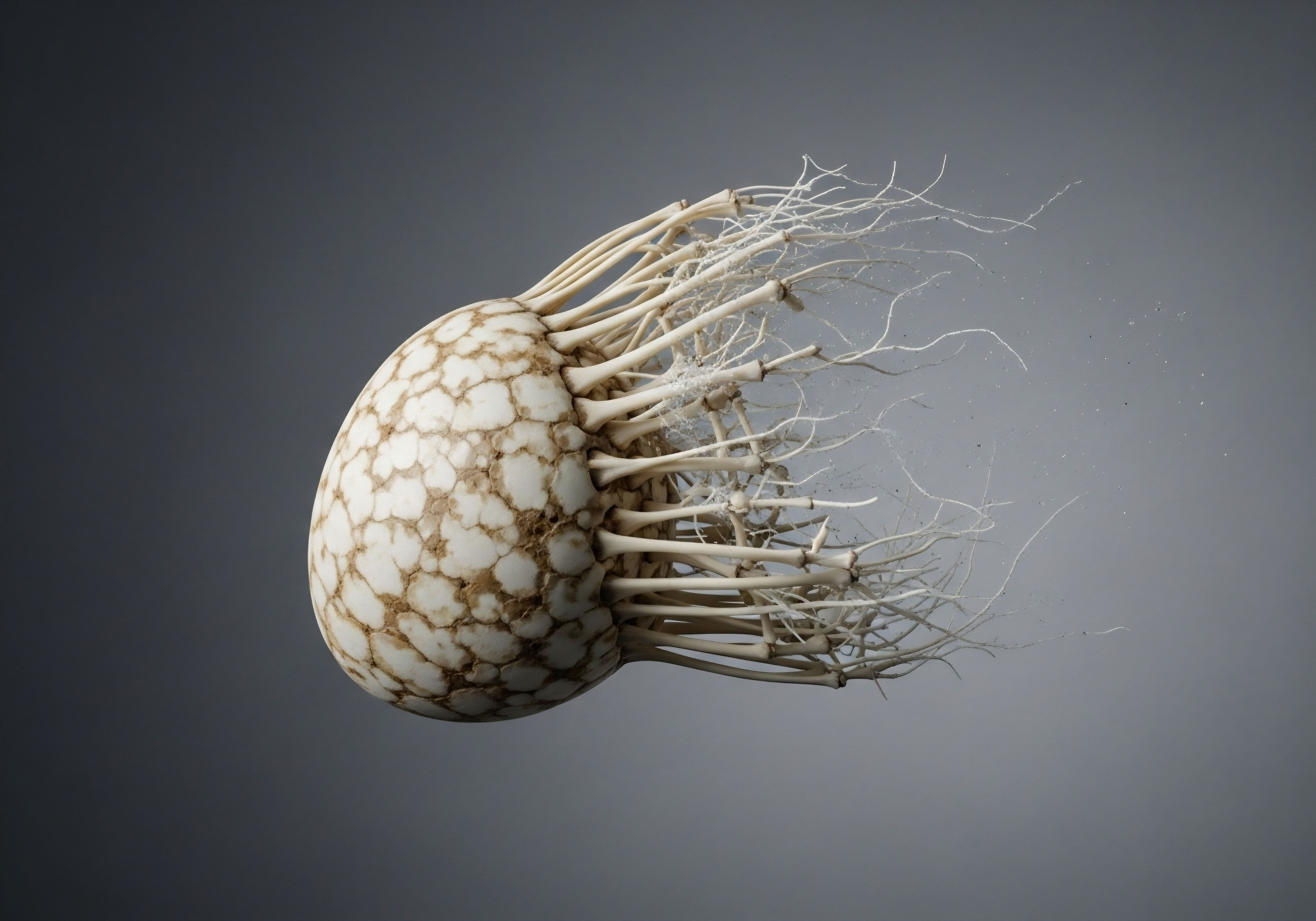

Fundamentals
Your experience of pain is a dynamic and deeply personal event, a perception your brain constructs from a constant stream of information. The intensity of this perception is profoundly influenced by the body’s internal chemical messengers, the hormones that orchestrate your physiology.
When you notice that your sensitivity to discomfort shifts, seemingly without a clear cause, you are observing a fundamental biological reality. This connection is an elegant example of the body’s integrated communication network, where the endocrine system directly informs the nervous system’s interpretation of sensory input.
The sensation of pain originates as a signal, but its final volume is tuned by specific hormonal conductors. Think of these hormones as sophisticated modulators within your body’s vast electrical grid. They do not create the initial signal, yet they possess the authority to amplify, dampen, or sustain it. This biological dialogue explains why pain can feel different from one week to the next, connecting your subjective experience to the precise, measurable rhythms of your internal environment.
Hormones act as primary regulators of the nervous system, directly adjusting the intensity of pain signals processed by the brain.

The Primary Hormonal Modulators of Sensation
Three principal hormones orchestrate the body’s response to painful stimuli. Their balance and concentration create a unique internal environment that dictates your sensitivity threshold. Understanding their individual roles is the first step in decoding your own patterns of discomfort and vitality.
- Estradiol This is the most potent form of estrogen. Its relationship with pain is complex and defined by its stability. Consistent, optimal levels of estradiol are associated with analgesic, or pain-reducing, effects. It supports neurotransmitters that soothe the nervous system. Conversely, sharp declines or fluctuations in estradiol levels correlate with a lower pain threshold, a phenomenon observed in the days leading up to menstruation or during the perimenopausal transition.
- Progesterone Often working in concert with estradiol, progesterone exerts a calming influence on the nervous system. It has known anti-inflammatory properties and can enhance the function of GABA, a neurotransmitter that promotes tranquility. Its presence during certain phases of the menstrual cycle contributes to a sense of well-being and can temper pain perception.
- Testosterone This hormone, vital for both men and women, has a clear and direct analgesic effect. It helps build resilience within the nervous system and is linked to a higher pain threshold. When testosterone levels are robust, the body’s ability to tolerate discomfort is enhanced. Its gradual decline with age is often correlated with an increase in chronic pain conditions.


Intermediate
To comprehend how hormonal shifts translate into physical sensation, we must examine the specific biological pathways they command. These chemical messengers interact directly with the nervous system at a cellular level, altering how pain signals are transmitted, interpreted, and perceived. This process involves a sophisticated interplay between nerve cells, immune cells, and inflammatory markers, all governed by the prevailing hormonal milieu.

How Do Hormones Interact with Pain Pathways?
Hormones function by binding to specific receptors located on cells throughout the body, including the brain, spinal cord, and peripheral nerves. This binding action initiates a cascade of downstream effects, effectively rewriting the rules of engagement for pain signaling. Stable hormonal levels create a predictable and resilient nervous system, while fluctuations introduce variability and can heighten sensitivity.
For instance, the sharp drop in estradiol preceding menstruation is a well-documented trigger for menstrual migraines. This occurs because blood vessels in the brain, which are rich in estrogen receptors, lose their stable hormonal support, leading to vascular changes and the onset of pain. In a similar fashion, the low-estrogen, low-progesterone state of the early menstrual phase is linked to increased inflammatory responses, which can amplify the pain of conditions like endometriosis or fibromyalgia.
Hormonal stability is a key determinant of pain resilience, with fluctuating levels often increasing vulnerability to pain triggers.

Clinical Manifestations of Hormonal Pain Modulation
The influence of hormones on pain is not merely theoretical; it is observable in numerous clinical conditions. The patterns of these conditions often provide a clear map of an individual’s underlying hormonal state. Recognizing these connections is a critical step toward developing targeted and effective wellness protocols.
- Fibromyalgia Individuals with fibromyalgia often report a cyclical worsening of symptoms. Research points to the luteal phase of the menstrual cycle, where progesterone is high but estrogen begins to fall, as a period of increased pain sensitivity for many women with this condition.
- Temporomandibular Joint (TMJ) Pain The prevalence of TMJ disorders is significantly higher in women. Evidence suggests that estrogen fluctuations influence the inflammation and laxity of the ligaments in the jaw, while testosterone appears to offer a protective, analgesic effect on the joint.
- Irritable Bowel Syndrome (IBS) Many women with IBS experience an increase in abdominal pain and rectal sensitivity during the menstrual phase. This correlates with the withdrawal of both estrogen and progesterone, which affects smooth muscle contraction and visceral nerve signaling.
The following table outlines the primary modulatory effects of key hormones on the systems that govern pain perception.
| Hormone | Effect on Nervous System | Influence on Inflammation |
|---|---|---|
| Estradiol (Stable) | Promotes serotonin and dopamine; enhances endogenous opioid function. | Generally anti-inflammatory, stabilizing immune cell response. |
| Estradiol (Fluctuating) | Disrupts neurotransmitter balance; can lead to neuronal hyperexcitability. | Promotes pro-inflammatory pathways upon withdrawal. |
| Progesterone | Enhances GABAergic activity (calming); promotes restorative sleep. | Potently anti-inflammatory; modulates cytokine production. |
| Testosterone | Exerts direct analgesic effects; supports myelin sheath integrity. | Suppresses pro-inflammatory cytokines; promotes tissue repair. |


Academic
A deeper analysis reveals that the influence of sex hormones on pain perception is mediated through their profound effects on neuroinflammation and the phenomenon of central sensitization. This process involves the dynamic interplay between neurons and glial cells, the resident immune cells of the central nervous system. Hormonal fluctuations can shift glial cells from a resting, supportive state into an activated, pro-inflammatory state, fundamentally altering the synaptic environment and lowering the threshold for pain activation.

What Is the Role of Glial Cell Activation in Hormonal Pain?
Microglia and astrocytes, the primary glial cells, are now understood to be active participants in pain processing. These cells are densely populated with estrogen receptors (ERα and ERβ) and other steroid hormone receptors. When activated by triggers such as a sharp drop in estradiol, these cells release a cascade of inflammatory mediators, including cytokines like tumor necrosis factor-alpha (TNF-α) and interleukin-1β (IL-1β).
These mediators act directly on neurons, increasing their excitability and responsiveness to stimuli. This state of heightened reactivity is the cellular basis of central sensitization, a key feature of many chronic pain states.
This mechanism explains why a stimulus that would normally be innocuous can be perceived as painful during certain hormonal states. The nervous system is operating at a higher baseline level of alert. Research in transgender individuals undergoing hormonal therapy provides a compelling human model for this process.
Male-to-female subjects initiating estrogen therapy have reported the development of chronic pain and a heightened sensitivity to thermal stimuli, illustrating the powerful role of hormonal changes in unmasking or inducing a sensitized pain state.
Fluctuating hormone levels can activate the immune cells of the nervous system, creating a pro-inflammatory environment that leads to chronic pain sensitization.

Molecular Mechanisms and Systemic Integration
The integration of the endocrine, nervous, and immune systems creates a complex feedback loop that determines overall pain sensitivity. The Hypothalamic-Pituitary-Gonadal (HPG) axis, which governs the production of sex hormones, is itself modulated by stress, sleep, and metabolic health. A disruption in one area inevitably impacts the others, creating a systemic vulnerability to pain.
The table below details specific molecular interactions that link hormonal changes to the mechanisms of central sensitization.
| Mediator | Hormonal Influence | Effect on Pain Pathway |
|---|---|---|
| Brain-Derived Neurotrophic Factor (BDNF) | Estradiol withdrawal can upregulate BDNF expression in the spinal cord. | Enhances synaptic plasticity and lowers the threshold for neuronal activation (allodynia). |
| Toll-Like Receptor 4 (TLR4) | Activated on microglial cells in response to hormonal shifts. | Initiates the pro-inflammatory cytokine cascade, driving neuroinflammation. |
| N-methyl-D-aspartate (NMDA) Receptor | Function is modulated by estradiol levels. Fluctuations can increase receptor sensitivity. | A key receptor in learning and memory, its over-activation contributes to the “wind-up” and persistence of chronic pain signals. |
| Endocannabinoid System | Estradiol enhances the expression of cannabinoid receptors (CB1). | Stable estrogen supports the body’s natural pain-relief system; falling estrogen weakens it. |

References
- Craft, Rebecca M. “The role of sex hormones in pain.” In Translational Pain Research, pp. 385-412. Academic Press, 2019.
- Vincent, K. and I. Tracey. “Hormones and their interaction with the pain experience.” Reviews in Pain 2, no. 2 (2008) ∞ 2-7.
- Martin, Vincent T. “Ovarian hormones and pain response ∞ a review of clinical and basic science studies.” Gender Medicine 6 (2009) ∞ 168-192.
- Aloisi, Anna Maria, and Ilaria Bonifazi. “Sex hormones, central nervous system and pain.” Hormones and Behavior 50, no. 1 (2006) ∞ 1-7.
- Chakour, M. et al. “The Role of Sex Hormones in Pain-Related Conditions.” Cureus 15, no. 1 (2023) ∞ e33910.
- Sorge, Robert E. and Jeffrey S. Mogil. “Sex differences in pain.” In The Oxford Handbook of Pain and Aging, edited by Joseph W. Shega and Thomas M. Meuser, 107-118. Oxford University Press, 2013.
- Bartley, E. J. and R. B. Fillingim. “Sex differences in pain ∞ a brief review of clinical and experimental findings.” British Journal of Anaesthesia 111, no. 1 (2013) ∞ 52-58.

Reflection
The knowledge that your internal hormonal rhythm is intrinsically linked to your perception of the world provides a powerful framework for self-awareness. Your experiences are validated by these complex biological systems. Understanding these connections is the foundational step in a personal journey toward reclaiming function and vitality.
This information empowers you to ask more precise questions and seek solutions that honor the intricate design of your own physiology, moving from a state of reaction to one of proactive stewardship of your health.



